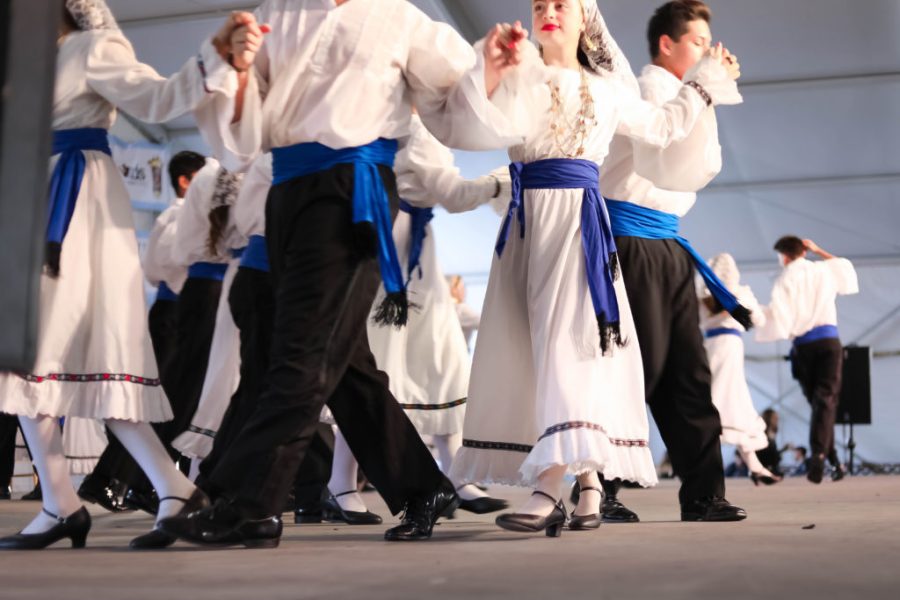The Sights, Sounds and History of SLC’s Greek Festival
September 14, 2022
I recently had the opportunity to visit the opening day of the Salt Lake City Greek Festival which takes place every Sept. 9-11. Not only was I bombarded with a delicious array of traditional Greek foods and pastries, but I was also immersed in the unique culture of Greek folk dance, music, jewelry, traditional clothing and fascinating history that has existed in Utah for over 120 years.
The History of Old Greektown
The neighborhood of old Greektown is located on the western flank of downtown Salt Lake City. The hallmark of this district is the distinct Holy Trinity Cathedral. Having been constructed and consecrated in 1920, it serves as the largest Eastern Orthodox parish east of Chicago. Although old Greektown has been relegated to only two blocks, it once used to be the mecca of Greek immigrants to Utah at the turn of the century.
Utah served as a promising location for Greek immigrants who were seeking labor in need of money to send back to the fatherland. The mass amounts of copper found in the Oquirrh mountains and many train tracks crossing the state made immigrant labor a necessity for many labor foremen who knew they could unfairly take advantage of Greek immigrants in desperate need of work.
Even though Greeks endured difficult working conditions and discrimination in the greater Mormon society, they were able to maintain a strong sense of community and tradition, establishing Greektown and constructing the Holy Trinity Cathedral. The importance and reliance placed on community are what has brought us the Greek Festival we know today.
Where Traditionalism and Modernity Meet
The Greek Festival has been a greatly anticipated event for nearly 50 years, first being celebrated in 1976 put together by the Holy Trinity Cathedral and sponsored by local and international businesses. The festival pays homage to the rich history of Greeks in Utah and brings traditional styles of Greek dance set to an assortment of Pan-Hellenic music. The dancers move in styles that harken back to the Byzantine Empire, the oldest being Kalamatiano which is a type of Syrto dancing, meaning “to drag or pull.” This dancing is often recognized for its special silk handkerchiefs that are held between dancers to separate each other’s hands. T
he festival has five separate groups of equally talented dancers performing from 12-10 p.m., entertaining audiences as they feast on delicious traditional Greek foods. The classic gyro with lamb seemed to be the crowd’s favorite, while side dishes of dolmaths, grape leaves filled with beef and rice, pastichio, Greek lasagna, spanakopita and baklava are just a few more of the mouth-watering options served at the festival. My personal favorite dessert had to be the loukoumades, a hollow deep-fried doughnut hole rolled in honey and cinnamon.
The Importance of Cultural Celebrations
The Greek Festival is known as one of the greatest “ethnic” festivals in the United States. Not only is there terrific entertainment and food, but the festival includes a market of small Greek businesses, tours through the historical cathedral and in 1992, the Hellenic Museum opened to the public and still stands as the only Greek museum in the U.S.
I was struck by the beauty of the degree to which this culture of people has survived and thrived despite gentrification, early xenophobia and a shift toward secular beliefs. It is a testament to the important role visibility and celebration play in keeping niche cultures and traditions alive and upheld.
I for one was able to learn a great deal about Greek history in Utah, and it was a joy to witness even a slice of the deep and full heritage they share.
The Greek Festival pulls about 50,000 patrons every year with which a portion of the money they collect goes back into charities around Utah and communities in need centered in Salt Lake City.
I implore everyone to check out and support the Greek Festival held at the Holy Trinity Cathedral every Sept. 9-11, not only to taste the wonderful food and enjoy the talented dancers but to immerse yourself in and support local communities around Salt Lake. In the celebration of many, we truly become one.







